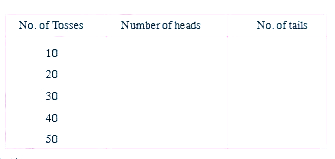Answer
Step by step text solution for Toss a coin for number of times as shown in the table. And record your findings in the table. What happens if you keep on increasing the number of tosses. by MATHS experts to help you in doubts & scoring excellent marks in Class 9 exams.
|
Topper's Solved these Questions
PROBABILITY
NCERT GUJARATI|Exercise THINK, DISCUSS AND WRITE|3 VideosView PlaylistPOLYNOMIALS AND FACTORISATION
NCERT GUJARATI|Exercise TRY THESE|5 VideosView PlaylistPROOFS IN MATHEMATICS
NCERT GUJARATI|Exercise EXERCISE - 15.4|15 VideosView Playlist
Similar Questions
Explore conceptually related problems
Knowledge Check
A
B
C
D
Submit
A
B
C
D
Submit
Similar Questions
Explore conceptually related problems
